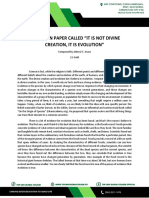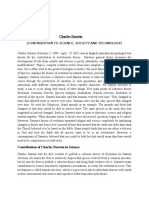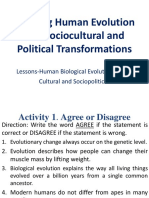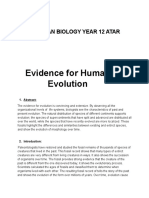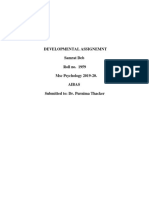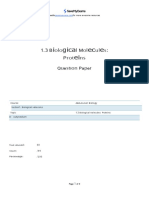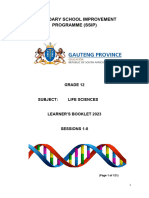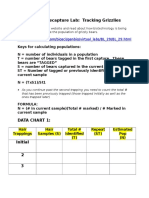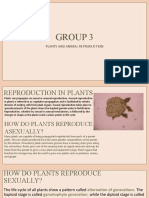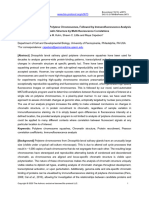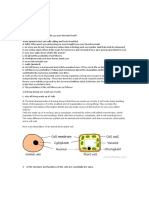Charles Dawin's Theory of Evolution
Charles Dawin's Theory of Evolution
Uploaded by
Elwin0 ratings0% found this document useful (0 votes)
12 views2 pagesAnaximander of Miletus was one of the earliest philosophers to propose ideas about how organisms change over time, suggesting that humans descended from fish-like creatures. His idea was not considered a scientific theory, as it could not be tested. A theory requires rigorous testing through observations and experiments. It was not until Charles Darwin published On the Origin of Species that evolution reached the status of a scientific theory. Darwin and Alfred Russel Wallace proposed the mechanism of natural selection, where organisms better suited to their environment are more likely to survive and reproduce, passing on their traits. Natural selection remains a key mechanism of evolution, though genetic drift can also cause evolution through chance variation in reproductive success.
Original Description:
Copyright
© © All Rights Reserved
Available Formats
DOCX, PDF, TXT or read online from Scribd
Share this document
Did you find this document useful?
Is this content inappropriate?
Anaximander of Miletus was one of the earliest philosophers to propose ideas about how organisms change over time, suggesting that humans descended from fish-like creatures. His idea was not considered a scientific theory, as it could not be tested. A theory requires rigorous testing through observations and experiments. It was not until Charles Darwin published On the Origin of Species that evolution reached the status of a scientific theory. Darwin and Alfred Russel Wallace proposed the mechanism of natural selection, where organisms better suited to their environment are more likely to survive and reproduce, passing on their traits. Natural selection remains a key mechanism of evolution, though genetic drift can also cause evolution through chance variation in reproductive success.
Copyright:
© All Rights Reserved
Available Formats
Download as DOCX, PDF, TXT or read online from Scribd
Download as docx, pdf, or txt
0 ratings0% found this document useful (0 votes)
12 views2 pagesCharles Dawin's Theory of Evolution
Charles Dawin's Theory of Evolution
Uploaded by
ElwinAnaximander of Miletus was one of the earliest philosophers to propose ideas about how organisms change over time, suggesting that humans descended from fish-like creatures. His idea was not considered a scientific theory, as it could not be tested. A theory requires rigorous testing through observations and experiments. It was not until Charles Darwin published On the Origin of Species that evolution reached the status of a scientific theory. Darwin and Alfred Russel Wallace proposed the mechanism of natural selection, where organisms better suited to their environment are more likely to survive and reproduce, passing on their traits. Natural selection remains a key mechanism of evolution, though genetic drift can also cause evolution through chance variation in reproductive success.
Copyright:
© All Rights Reserved
Available Formats
Download as DOCX, PDF, TXT or read online from Scribd
Download as docx, pdf, or txt
You are on page 1of 2
Ideas aimed at explaining how
organisms change, or evolve, over time
date back to Anaximander of Miletus, a Greek philosopher who lived
in the 500s B.C.E. Noting that human babies are born helpless,
Anaximander speculated that humans must have descended from
some other type of creature whose young could survive without any
help. He concluded that those ancestors must be fish, since fish hatch
from eggs and immediately begin living with no help from their
parents. From this reasoning, he proposed that all life began in the
sea.
Anaximander was correct; humans can indeed trace our ancestry
back to fish. His idea, however, was not a theory in the scientific
meaning of the word, because it could not be subjected to testing that
might support it or prove it wrong. In science, the word “theory”
indicates a very high level of certainty. Scientists talk
about evolution as a theory, for instance, just as they talk about
Einstein’s explanation of gravity as a theory.
A theory is an idea about how something in nature works that has
gone through rigorous testing through observations and experiments
designed to prove the idea right or wrong. When it comes to the
evolution of life, various philosophers and scientists, including an
eighteenth-century English doctor named Erasmus Darwin, proposed
different aspects of what later would become evolutionary theory. But
evolution did not reach the status of being a scientific theory until
Darwin’s grandson, the more famous Charles Darwin, published his
famous book On the Origin of Species. Darwin and a scientific
contemporary of his, Alfred Russel Wallace, proposed
that evolution occurs because of a phenomenon called natural
selection.
In the theory of natural selection, organisms produce more offspring
than are able to survive in their environment. Those that are better
physically equipped to survive, grow to maturity, and reproduce.
Those that are lacking in such fitness, on the other hand, either do not
reach an age when they can reproduce or produce fewer offspring
than their counterparts. Natural selection is sometimes summed up as
“survival of the fittest” because the “fittest” organisms—those most
suited to their environment—are the ones that reproduce most
successfully, and are most likely to pass on their traits to the next
generation.
This means that if an environment changes, the traits that enhance
survival in that environment will also gradually change, or
evolve. Natural selection was such a powerful idea in explaining
the evolution of life that it became established as a
scientific theory. Biologists have since observed numerous examples
of natural selection influencing evolution. Today, it is known to be just
one of several mechanisms by which life evolves. For example, a
phenomenon known as genetic drift can also cause species to evolve.
In genetic drift, some organisms—purely by chance—produce more
offspring than would be expected. Those organisms are not
necessarily the fittest of their species, but it is their genes that get
passed on to the next generation.
You might also like
- Life The Science of Biology 12th Edition David M. Hillis 2024 Scribd DownloadDocument64 pagesLife The Science of Biology 12th Edition David M. Hillis 2024 Scribd Downloadkhonoaedla100% (3)
- Untitled Document-10Document1 pageUntitled Document-10Oscar MasindeNoch keine Bewertungen
- Bio ProjectDocument12 pagesBio ProjectCadine DavisNoch keine Bewertungen
- DarwinDocument3 pagesDarwinStudent AkashNoch keine Bewertungen
- Assignment: Theophilus Sahr MorsayDocument6 pagesAssignment: Theophilus Sahr MorsayKomba KangbaiNoch keine Bewertungen
- History of EvolutionDocument5 pagesHistory of EvolutionabdulbaiczariffainnieNoch keine Bewertungen
- Zoloogy Report BlindDocument8 pagesZoloogy Report BlindBlind BerwariNoch keine Bewertungen
- Descent With Modification and The Development of Evolutionary ThoughtDocument5 pagesDescent With Modification and The Development of Evolutionary ThoughtEvangelene Esquillo Sana100% (1)
- Biology 101Document5 pagesBiology 101KC AngelineNoch keine Bewertungen
- BiologyDocument25 pagesBiologypraveensivan22Noch keine Bewertungen
- PhilosophyDocument12 pagesPhilosophyAina Shane Flores YutucNoch keine Bewertungen
- Journal of Paleontology/FossilsDocument22 pagesJournal of Paleontology/FossilsAngelina RandaNoch keine Bewertungen
- Ace Tutorial GST 112 - 023048Document27 pagesAce Tutorial GST 112 - 023048Uteh AghoghoNoch keine Bewertungen
- 10.1 EvolutionDocument25 pages10.1 EvolutionNeuf RochesNoch keine Bewertungen
- Development of Evolutionary ThoughtDocument9 pagesDevelopment of Evolutionary Thoughtkaren milloNoch keine Bewertungen
- Darwin's Theory EssayDocument6 pagesDarwin's Theory EssayLogkeetha SarckunadasanNoch keine Bewertungen
- Lesson 1: Descent With Modification: Heredity and EvolutionDocument3 pagesLesson 1: Descent With Modification: Heredity and EvolutionJhay Luiz Cajigal ArquinesNoch keine Bewertungen
- Does Refuting The Darwinian Theory of Evolution Imply Refuting Animal and Plant Evolution?Document5 pagesDoes Refuting The Darwinian Theory of Evolution Imply Refuting Animal and Plant Evolution?Khan SabNoch keine Bewertungen
- Life Heritable Traits Biological Populations Generations Biological Organisation Species Organisms MoleculesDocument8 pagesLife Heritable Traits Biological Populations Generations Biological Organisation Species Organisms MoleculesCMG RainNoch keine Bewertungen
- Human Ecology ReportDocument91 pagesHuman Ecology Reportian maravillaNoch keine Bewertungen
- Origin of WhalesDocument7 pagesOrigin of WhalesJordan MosesNoch keine Bewertungen
- Darwin's Theory of Evolution: Name - Class - DateDocument3 pagesDarwin's Theory of Evolution: Name - Class - DateAni Coca KollaNoch keine Bewertungen
- Atestat EnglezaDocument44 pagesAtestat EnglezaCarmen OlteanuNoch keine Bewertungen
- College of Education Daraga, AlbayDocument5 pagesCollege of Education Daraga, AlbayJan Chris GileNoch keine Bewertungen
- Prepared By: Catherine Dela Rosa RamosDocument17 pagesPrepared By: Catherine Dela Rosa RamosOliver NaragNoch keine Bewertungen
- Darwin's Theory of Evolution ?Document13 pagesDarwin's Theory of Evolution ?Dark mayersNoch keine Bewertungen
- Evolution and Natural SelectionDocument7 pagesEvolution and Natural SelectionMichelleneChenTadleNoch keine Bewertungen
- Position Paper About Evolution 1Document3 pagesPosition Paper About Evolution 1Johnryl AraosNoch keine Bewertungen
- Lecture 2Document15 pagesLecture 2listoproNoch keine Bewertungen
- Biological EvolutionDocument54 pagesBiological EvolutionMa. Krizia Tiny ParconNoch keine Bewertungen
- Evolutionary Theory: A Jumble of DeceptionsDocument4 pagesEvolutionary Theory: A Jumble of DeceptionsMubashir HassanNoch keine Bewertungen
- Scientific Article1Document3 pagesScientific Article1ADRIANA SOFIA SEBA TIBOCHANoch keine Bewertungen
- Darwinian TheoryDocument15 pagesDarwinian TheoryVivialyn BanguilanNoch keine Bewertungen
- EvolutionDocument14 pagesEvolutionARYAGARA KRISTANDY RUKMANA PUTRANoch keine Bewertungen
- Earth and Life Science. Chapter 10Document18 pagesEarth and Life Science. Chapter 10veronicaNoch keine Bewertungen
- Bio ProjectDocument17 pagesBio ProjectSpectra DragneelNoch keine Bewertungen
- Fixity of SpeciesDocument8 pagesFixity of Species'Lab Qou'Noch keine Bewertungen
- Charles Darwin: (Contribution To Science, Society and Technology)Document2 pagesCharles Darwin: (Contribution To Science, Society and Technology)Edhel CabalquintoNoch keine Bewertungen
- Evo Bio Midterm NotesDocument21 pagesEvo Bio Midterm NotesShareeze GomezNoch keine Bewertungen
- Darwin's Theory of EvolutionDocument8 pagesDarwin's Theory of EvolutionRazelle Olendo100% (1)
- Human Evolution Observation - 2Document27 pagesHuman Evolution Observation - 2daisylabasanNoch keine Bewertungen
- Reading Practice 2Document2 pagesReading Practice 2Fadhila SyarifatunNoch keine Bewertungen
- Evidence For Human EvolutionDocument6 pagesEvidence For Human EvolutionThanh Khuê LêNoch keine Bewertungen
- Pagel 2009 - Natural Selection 150 Years OnDocument4 pagesPagel 2009 - Natural Selection 150 Years OnCamilo GarcíaNoch keine Bewertungen
- EvolutionDocument65 pagesEvolutionJaeden AnsNoch keine Bewertungen
- Ethological Theories of DevelopmentDocument10 pagesEthological Theories of DevelopmentSamrat Deb AIBASMUMNoch keine Bewertungen
- Charles Robert DarwinDocument2 pagesCharles Robert DarwinAsterisk AngeloNoch keine Bewertungen
- Teori Evolusi Terhadap Perkembangan Klasifikasi Makhluk Hidup Hilma Suhailah Rizky Hasibuan (1302619045)Document10 pagesTeori Evolusi Terhadap Perkembangan Klasifikasi Makhluk Hidup Hilma Suhailah Rizky Hasibuan (1302619045)TikaNoch keine Bewertungen
- Lesson 6: Evolution & Genetics: Conrad KottakDocument10 pagesLesson 6: Evolution & Genetics: Conrad KottakSpencer De LimaNoch keine Bewertungen
- Evolution: ES 121/L - Evolutionary BiologyDocument42 pagesEvolution: ES 121/L - Evolutionary BiologyChel SyNoch keine Bewertungen
- Spiritual Scientist - Evolution TSSDocument31 pagesSpiritual Scientist - Evolution TSSKrishal BhattaraiNoch keine Bewertungen
- Theory of Evolution by Natural SelectionDocument15 pagesTheory of Evolution by Natural Selectionpaula nicolle mostoles100% (1)
- Grade 10 - Q3 - L3Document38 pagesGrade 10 - Q3 - L3Jake Aldred CabelaNoch keine Bewertungen
- G-12 Biology, 4.2 Theories of EvolutionDocument4 pagesG-12 Biology, 4.2 Theories of EvolutionYohannes NigussieNoch keine Bewertungen
- Toefl Reading (Practice)Document10 pagesToefl Reading (Practice)MARYLAND Pedagogical CoordinationNoch keine Bewertungen
- William Doss McDavid - (1984) Evolution and The Secret DoctrineDocument5 pagesWilliam Doss McDavid - (1984) Evolution and The Secret DoctrineSebastian VillasecaNoch keine Bewertungen
- Theories of EvolutionDocument3 pagesTheories of Evolutionomgbabe123100% (1)
- For BioDocument5 pagesFor BioAika Mae ArakakiNoch keine Bewertungen
- What Is Darwins Theory of EvolutionDocument5 pagesWhat Is Darwins Theory of EvolutionRakesh MeherNoch keine Bewertungen
- LT Adm 16.5Document9 pagesLT Adm 16.5Bayani VicencioNoch keine Bewertungen
- Lesson Plan-Cell CycleDocument3 pagesLesson Plan-Cell CycleQueencess Ara TorresNoch keine Bewertungen
- 9511Document33 pages9511Trân GemNoch keine Bewertungen
- Pathology 09.11.2020 11.09.01.034Document1 pagePathology 09.11.2020 11.09.01.034Subhajit RoyNoch keine Bewertungen
- Worksheet 2 ProteinsDocument9 pagesWorksheet 2 ProteinsSahar GhanemNoch keine Bewertungen
- L11 - Cytogenetic TechniquesDocument4 pagesL11 - Cytogenetic TechniquesDea Marienila CuberoNoch keine Bewertungen
- RNA SplicingDocument8 pagesRNA SplicingDivya NarayanNoch keine Bewertungen
- CH 1 The History and ScopeDocument21 pagesCH 1 The History and ScopeBronwyn JuliusNoch keine Bewertungen
- 20 Emotional Mastery of The Trading Mind - Part 1 - The Survival Based Biases That Are Robbing Your PotentialDocument3 pages20 Emotional Mastery of The Trading Mind - Part 1 - The Survival Based Biases That Are Robbing Your PotentialArwin Greg100% (1)
- Targeted Genome Editing With A DNA-dependent DNA Polymerase and Exogenous DNA-containing TemplatesDocument21 pagesTargeted Genome Editing With A DNA-dependent DNA Polymerase and Exogenous DNA-containing TemplatesSabranth GuptaNoch keine Bewertungen
- Life Sciences Ssip Learner Booklet Sessions 1-8-2023Document124 pagesLife Sciences Ssip Learner Booklet Sessions 1-8-2023thabomakgatho64Noch keine Bewertungen
- BIOLOGY - Reproductive Strategies (Sexual and Asexual) ReviewerDocument2 pagesBIOLOGY - Reproductive Strategies (Sexual and Asexual) ReviewerTRISHA MARIE CLEMENTENoch keine Bewertungen
- Plant Anatomy, Embryology and PalynolgyDocument21 pagesPlant Anatomy, Embryology and PalynolgyRaajashekkar ReddyNoch keine Bewertungen
- Rosalind Elsie FranklinDocument9 pagesRosalind Elsie Franklinvpolyakova07Noch keine Bewertungen
- Dissertation Sabrina KilleDocument8 pagesDissertation Sabrina KilleHelpWritingCollegePapersUK100% (1)
- Virtual Mark Recapture Lab - Tracking GrizzliesDocument5 pagesVirtual Mark Recapture Lab - Tracking GrizzliesAmelia Fattis Purgos50% (2)
- Week1 - The Cell and Its Structures and FunctionsDocument30 pagesWeek1 - The Cell and Its Structures and FunctionsFundal Elaine Mae UmbaoNoch keine Bewertungen
- 3.4 The Effect of The Interaction of Genotype and The Environment On PhenotypeDocument13 pages3.4 The Effect of The Interaction of Genotype and The Environment On PhenotypeOmar ZraikatNoch keine Bewertungen
- Job Opportunities: 1 2 3 4 5 Sr. No. Post With Scale Total Posts Minimum Qualification & Experience Age LimitDocument4 pagesJob Opportunities: 1 2 3 4 5 Sr. No. Post With Scale Total Posts Minimum Qualification & Experience Age LimitNoman AhmedNoch keine Bewertungen
- 2ndQ SECOND SUMMATIVE TEST EARTH AND LIFEDocument2 pages2ndQ SECOND SUMMATIVE TEST EARTH AND LIFEJarven SaguinNoch keine Bewertungen
- Group 3 Plants and Animals ReproductionDocument25 pagesGroup 3 Plants and Animals ReproductionPateña Nicole Ferdilette DiñozoNoch keine Bewertungen
- Agustus-juli-Ke 21 PiraDocument129 pagesAgustus-juli-Ke 21 PiraErlanda ThegarNoch keine Bewertungen
- Preparation of Drosophila Polytene ChromosomesDocument19 pagesPreparation of Drosophila Polytene ChromosomesKavisa GhoshNoch keine Bewertungen
- Math and Physical Sciences Reference StyleDocument3 pagesMath and Physical Sciences Reference StyleSetBonNoch keine Bewertungen
- Application of Biotechnology in AnimalsDocument5 pagesApplication of Biotechnology in AnimalsWycliffe AsmanNoch keine Bewertungen
- Yearbook 2022Document388 pagesYearbook 2022InhumanNoch keine Bewertungen
- Comic StripDocument2 pagesComic StripSatori TendōNoch keine Bewertungen
- IPR Research Paper 1501025202Document26 pagesIPR Research Paper 1501025202ira singhalNoch keine Bewertungen
- Hickman 2021Document527 pagesHickman 2021DANTE JOSE AUGUSTO ALFARO NUNEZNoch keine Bewertungen



























